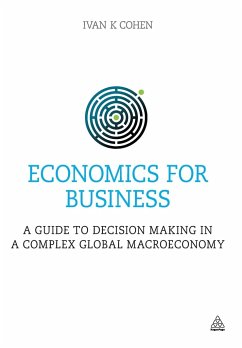- Broschiertes Buch
- Merkliste
- Auf die Merkliste
- Bewerten Bewerten
- Teilen
- Produkt teilen
- Produkterinnerung
- Produkterinnerung
Economics for Business enables the reader to develop a clear understanding of the economic environment in which business takes place. This comprehensive book covers: the process of globalization and its implications for business; the role of the market and supply and demand; the impact of demand on branding and brand loyalty; and pricing strategies under various market structures. With specific business content integrated throughout and a global perspective on the current world of business, taking into account the financial crisis and its aftermath, Economics for Business is a useful…mehr
Andere Kunden interessierten sich auch für
![The European Monetary Union The European Monetary Union]() Nicola AcocellaThe European Monetary Union45,99 €
Nicola AcocellaThe European Monetary Union45,99 €![Macroeconomics for Business and Society: A Developed/Developing Country Perspective on the New Economy Macroeconomics for Business and Society: A Developed/Developing Country Perspective on the New Economy]() F Gerard AdamsMacroeconomics for Business and Society: A Developed/Developing Country Perspective on the New Economy57,99 €
F Gerard AdamsMacroeconomics for Business and Society: A Developed/Developing Country Perspective on the New Economy57,99 €![Principles of Knowledge Management Principles of Knowledge Management]() Eliezer GeislerPrinciples of Knowledge Management86,99 €
Eliezer GeislerPrinciples of Knowledge Management86,99 €![Growth, Inequality, and Poverty Growth, Inequality, and Poverty]() Anthony Shorrocks / Rolph Van Der Hoeven (eds.)Growth, Inequality, and Poverty81,99 €
Anthony Shorrocks / Rolph Van Der Hoeven (eds.)Growth, Inequality, and Poverty81,99 €![Beyond Our Means Beyond Our Means]() Sheldon GaronBeyond Our Means28,99 €
Sheldon GaronBeyond Our Means28,99 €![International Business International Business]() Riad AjamiInternational Business91,99 €
Riad AjamiInternational Business91,99 €![Foundations of International Economics Foundations of International Economics]() Foundations of International Economics107,99 €
Foundations of International Economics107,99 €-
-
-
Economics for Business enables the reader to develop a clear understanding of the economic environment in which business takes place. This comprehensive book covers: the process of globalization and its implications for business; the role of the market and supply and demand; the impact of demand on branding and brand loyalty; and pricing strategies under various market structures. With specific business content integrated throughout and a global perspective on the current world of business, taking into account the financial crisis and its aftermath, Economics for Business is a useful introduction to economics for business students, a streamlined and comprehensive alternative to large undergraduate economics textbooks, and a valuable resource for managers and executives who need to understand the basics of economic concepts to grow their business. Online supporting resources for this book include bonus chapters on shareholders, trading blocs and skills groupings, a glossary, history of economics and an instructor's manual.
Hinweis: Dieser Artikel kann nur an eine deutsche Lieferadresse ausgeliefert werden.
Hinweis: Dieser Artikel kann nur an eine deutsche Lieferadresse ausgeliefert werden.
Produktdetails
- Produktdetails
- Verlag: Kogan Page
- Seitenzahl: 360
- Erscheinungstermin: 24. November 2015
- Englisch
- Abmessung: 244mm x 170mm x 19mm
- Gewicht: 621g
- ISBN-13: 9780749470197
- ISBN-10: 0749470194
- Artikelnr.: 42953338
- Herstellerkennzeichnung
- Libri GmbH
- Europaallee 1
- 36244 Bad Hersfeld
- gpsr@libri.de
- Verlag: Kogan Page
- Seitenzahl: 360
- Erscheinungstermin: 24. November 2015
- Englisch
- Abmessung: 244mm x 170mm x 19mm
- Gewicht: 621g
- ISBN-13: 9780749470197
- ISBN-10: 0749470194
- Artikelnr.: 42953338
- Herstellerkennzeichnung
- Libri GmbH
- Europaallee 1
- 36244 Bad Hersfeld
- gpsr@libri.de
Ivan K. Cohen is Associate Professor in Finance and Economics at Richmond University, the American International University based in London. With many years of teaching experience across a wide range of economics and finance classes and having taught on both sides of the Atlantic, he is able to offer a unique global approach to the study of economics.
Preface and Acknowledgements Key
Part One Introduction to economics and business
01 What's economics got to do with business? Objective Learning outcomes
Main topics covered The business environment What is economics? Some key
concepts in economics Economic institutions Summary References
02 Introduction to markets Objective Learning outcomes Main topics covered
What is a market? The role of the market Introduction to demand
Introduction to supply The market in theory The market in practice Summary
03 Introduction to the macroeconomy Objective Learning outcomes Main topics
covered Introduction About macroeconomics The circular flow of income
Measuring GDP This role of markets and government Aggregate expenditure The
income-expenditure model Aggregate supply Summary References
04 Introduction to the financial system Objective Learning outcomes Main
topics covered Introduction The core: money, an introduction The nature and
role of the financial system Financial markets Financial claims Financial
institutions Financial regulation Summary
Part Two Microeconomics: individual economic agents and institutions
05 Demand Objective Learning outcomes Main topics covered Introduction Why
demand exists The drivers of demand Product classification Marketing and
demand Summary References
06 The firm Objective Learning outcomes Main topics covered Introduction
The firm: legal definition The firm: functional definition Why firms exist
The firm in practice Financing firms Profits Summary References
07 Supply: costs, output and distribution Objective Learning outcomes Main
topics covered Introduction Production Inputs or factors of production The
production function Costs Price elasticity of supply Summary References
08 Competition, markets and strategy Objective Learning outcomes Main
topics covered Introduction Market structure: an overview Market structure
About strategy Pricing and strategy under perfect competition Pricing and
strategy under pure monopoly Pricing and strategy under imperfect
competition Contestable markets Other market structures: monopsony and
oligopsony Summary References
Part Three Macroeconomics: the business background
09 The role of government Objective Learning outcomes Main topics covered
Introduction The nature and role of government Infrastructure
Macro-intervention Fairness versus efficiency The failure of the market (or
markets) to achieve efficiency in allocating societal resources Summary
References
10 Money, interest rates and central banking: the role of monetary policy
Objective Learning outcomes Main topics covered Introduction Money The
importance of interest rates The origins of central banking The role of
central banks Summary References
11 Technology, innovation and investment Objective Learning outcomes Main
topics covered Introduction Capital Technology and innovation The economics
of investment Summary References
12 Forecasting Objective Learning outcomes Main topics covered Introduction
Introduction to forecasting Data collection Statistical analysis Summary
Further reading References
13 Employment: the human factor Objective Learning outcomes Main topics
covered Introduction Labour market terminology Trends in UK labour markets
The supply of labour The demand for labour Labour markets and competition
Summary References Appendix
14 The economics of international business Objective Learning outcomes Main
topics covered Introduction What is international trade? The growth of
world trade Why international trade occurs From international trade to
globalization International trade and politics International trade and
finance Exchange rate systems Exchange rate relationships Summary
References
Index
Part One Introduction to economics and business
01 What's economics got to do with business? Objective Learning outcomes
Main topics covered The business environment What is economics? Some key
concepts in economics Economic institutions Summary References
02 Introduction to markets Objective Learning outcomes Main topics covered
What is a market? The role of the market Introduction to demand
Introduction to supply The market in theory The market in practice Summary
03 Introduction to the macroeconomy Objective Learning outcomes Main topics
covered Introduction About macroeconomics The circular flow of income
Measuring GDP This role of markets and government Aggregate expenditure The
income-expenditure model Aggregate supply Summary References
04 Introduction to the financial system Objective Learning outcomes Main
topics covered Introduction The core: money, an introduction The nature and
role of the financial system Financial markets Financial claims Financial
institutions Financial regulation Summary
Part Two Microeconomics: individual economic agents and institutions
05 Demand Objective Learning outcomes Main topics covered Introduction Why
demand exists The drivers of demand Product classification Marketing and
demand Summary References
06 The firm Objective Learning outcomes Main topics covered Introduction
The firm: legal definition The firm: functional definition Why firms exist
The firm in practice Financing firms Profits Summary References
07 Supply: costs, output and distribution Objective Learning outcomes Main
topics covered Introduction Production Inputs or factors of production The
production function Costs Price elasticity of supply Summary References
08 Competition, markets and strategy Objective Learning outcomes Main
topics covered Introduction Market structure: an overview Market structure
About strategy Pricing and strategy under perfect competition Pricing and
strategy under pure monopoly Pricing and strategy under imperfect
competition Contestable markets Other market structures: monopsony and
oligopsony Summary References
Part Three Macroeconomics: the business background
09 The role of government Objective Learning outcomes Main topics covered
Introduction The nature and role of government Infrastructure
Macro-intervention Fairness versus efficiency The failure of the market (or
markets) to achieve efficiency in allocating societal resources Summary
References
10 Money, interest rates and central banking: the role of monetary policy
Objective Learning outcomes Main topics covered Introduction Money The
importance of interest rates The origins of central banking The role of
central banks Summary References
11 Technology, innovation and investment Objective Learning outcomes Main
topics covered Introduction Capital Technology and innovation The economics
of investment Summary References
12 Forecasting Objective Learning outcomes Main topics covered Introduction
Introduction to forecasting Data collection Statistical analysis Summary
Further reading References
13 Employment: the human factor Objective Learning outcomes Main topics
covered Introduction Labour market terminology Trends in UK labour markets
The supply of labour The demand for labour Labour markets and competition
Summary References Appendix
14 The economics of international business Objective Learning outcomes Main
topics covered Introduction What is international trade? The growth of
world trade Why international trade occurs From international trade to
globalization International trade and politics International trade and
finance Exchange rate systems Exchange rate relationships Summary
References
Index
Preface and Acknowledgements Key
Part One Introduction to economics and business
01 What's economics got to do with business? Objective Learning outcomes
Main topics covered The business environment What is economics? Some key
concepts in economics Economic institutions Summary References
02 Introduction to markets Objective Learning outcomes Main topics covered
What is a market? The role of the market Introduction to demand
Introduction to supply The market in theory The market in practice Summary
03 Introduction to the macroeconomy Objective Learning outcomes Main topics
covered Introduction About macroeconomics The circular flow of income
Measuring GDP This role of markets and government Aggregate expenditure The
income-expenditure model Aggregate supply Summary References
04 Introduction to the financial system Objective Learning outcomes Main
topics covered Introduction The core: money, an introduction The nature and
role of the financial system Financial markets Financial claims Financial
institutions Financial regulation Summary
Part Two Microeconomics: individual economic agents and institutions
05 Demand Objective Learning outcomes Main topics covered Introduction Why
demand exists The drivers of demand Product classification Marketing and
demand Summary References
06 The firm Objective Learning outcomes Main topics covered Introduction
The firm: legal definition The firm: functional definition Why firms exist
The firm in practice Financing firms Profits Summary References
07 Supply: costs, output and distribution Objective Learning outcomes Main
topics covered Introduction Production Inputs or factors of production The
production function Costs Price elasticity of supply Summary References
08 Competition, markets and strategy Objective Learning outcomes Main
topics covered Introduction Market structure: an overview Market structure
About strategy Pricing and strategy under perfect competition Pricing and
strategy under pure monopoly Pricing and strategy under imperfect
competition Contestable markets Other market structures: monopsony and
oligopsony Summary References
Part Three Macroeconomics: the business background
09 The role of government Objective Learning outcomes Main topics covered
Introduction The nature and role of government Infrastructure
Macro-intervention Fairness versus efficiency The failure of the market (or
markets) to achieve efficiency in allocating societal resources Summary
References
10 Money, interest rates and central banking: the role of monetary policy
Objective Learning outcomes Main topics covered Introduction Money The
importance of interest rates The origins of central banking The role of
central banks Summary References
11 Technology, innovation and investment Objective Learning outcomes Main
topics covered Introduction Capital Technology and innovation The economics
of investment Summary References
12 Forecasting Objective Learning outcomes Main topics covered Introduction
Introduction to forecasting Data collection Statistical analysis Summary
Further reading References
13 Employment: the human factor Objective Learning outcomes Main topics
covered Introduction Labour market terminology Trends in UK labour markets
The supply of labour The demand for labour Labour markets and competition
Summary References Appendix
14 The economics of international business Objective Learning outcomes Main
topics covered Introduction What is international trade? The growth of
world trade Why international trade occurs From international trade to
globalization International trade and politics International trade and
finance Exchange rate systems Exchange rate relationships Summary
References
Index
Part One Introduction to economics and business
01 What's economics got to do with business? Objective Learning outcomes
Main topics covered The business environment What is economics? Some key
concepts in economics Economic institutions Summary References
02 Introduction to markets Objective Learning outcomes Main topics covered
What is a market? The role of the market Introduction to demand
Introduction to supply The market in theory The market in practice Summary
03 Introduction to the macroeconomy Objective Learning outcomes Main topics
covered Introduction About macroeconomics The circular flow of income
Measuring GDP This role of markets and government Aggregate expenditure The
income-expenditure model Aggregate supply Summary References
04 Introduction to the financial system Objective Learning outcomes Main
topics covered Introduction The core: money, an introduction The nature and
role of the financial system Financial markets Financial claims Financial
institutions Financial regulation Summary
Part Two Microeconomics: individual economic agents and institutions
05 Demand Objective Learning outcomes Main topics covered Introduction Why
demand exists The drivers of demand Product classification Marketing and
demand Summary References
06 The firm Objective Learning outcomes Main topics covered Introduction
The firm: legal definition The firm: functional definition Why firms exist
The firm in practice Financing firms Profits Summary References
07 Supply: costs, output and distribution Objective Learning outcomes Main
topics covered Introduction Production Inputs or factors of production The
production function Costs Price elasticity of supply Summary References
08 Competition, markets and strategy Objective Learning outcomes Main
topics covered Introduction Market structure: an overview Market structure
About strategy Pricing and strategy under perfect competition Pricing and
strategy under pure monopoly Pricing and strategy under imperfect
competition Contestable markets Other market structures: monopsony and
oligopsony Summary References
Part Three Macroeconomics: the business background
09 The role of government Objective Learning outcomes Main topics covered
Introduction The nature and role of government Infrastructure
Macro-intervention Fairness versus efficiency The failure of the market (or
markets) to achieve efficiency in allocating societal resources Summary
References
10 Money, interest rates and central banking: the role of monetary policy
Objective Learning outcomes Main topics covered Introduction Money The
importance of interest rates The origins of central banking The role of
central banks Summary References
11 Technology, innovation and investment Objective Learning outcomes Main
topics covered Introduction Capital Technology and innovation The economics
of investment Summary References
12 Forecasting Objective Learning outcomes Main topics covered Introduction
Introduction to forecasting Data collection Statistical analysis Summary
Further reading References
13 Employment: the human factor Objective Learning outcomes Main topics
covered Introduction Labour market terminology Trends in UK labour markets
The supply of labour The demand for labour Labour markets and competition
Summary References Appendix
14 The economics of international business Objective Learning outcomes Main
topics covered Introduction What is international trade? The growth of
world trade Why international trade occurs From international trade to
globalization International trade and politics International trade and
finance Exchange rate systems Exchange rate relationships Summary
References
Index








